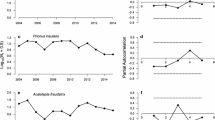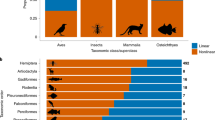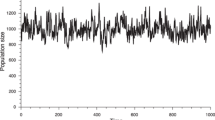Abstract
Most modern population dynamics analyses of time series use simple population indices for ecological inference. These indices, collected for many years for various agricultural pests or game animals, are generally believed not to distort systematically feedback estimates because the assumption of linearity to population size roughly holds. To assess the relative importance of this assumption, we examined the effect of nonlinearity in a burrow index for voles on feedback estimates obtained through autoregressive modeling. We show that the issue of linearity is of less importance to ecological inference because the feedback estimates are routinely obtained on a logarithmic scale. Transforming data to logs has a strong linearization effect, removing most of the nonlinearity observed on the original scale. We conclude that the statistical tools for ecological inference, such as autoregressive log-linear models, are sufficiently robust to the systematic error imposed by index nonlinearity and that indices are valuable sources of ecological information even in situations when the assumed linear functional forms to population size were not exactly validated. We suggest that for time series modelers, the issue of a large sampling variation in small “noisy” populations is by far a more burning one than the systematic error due to index nonlinearity.



Similar content being viewed by others
References
Anderson DR, Burnham KP, Thompson WL (2000) Null hypothesis testing: problems, prevalence, and an alternative. J Wildl Manage 64:912–923
Bjørnstad ON, Falck W, Stenseth NC (1995) A geographic gradient in small rodent density fluctuations: a statistical modeling approach. Proc R Soc Lond B 262:127–133
Bjørnstad ON, Champeley S, Stenseth NC, Saitoh T (1996) Cyclicity and stability of grey-sided voles, Clethrionomys rufocanus, of Hokkaido: spectral and principal components analyses. Phil Trans R Soc Lond B 351:867–875
Caughley G (1977) Analysis of vertebrate populations. Wiley, London
Eberhardt LL (1978) Appraising variability in population studies. J Wildl Manage 42:207–238
Elton C, Nicholson M (1942) The ten-year cycle in numbers of the lynx in Canada. J Anim Ecol 11:215–244
Forchhammer MC, Stenseth NC, Post E, Langvatn R (1998) Population dynamics of Norwegian red deer: density-dependence and climatic variation. Proc R Soc Lond B 265:341–350
Fowler CW (1988) Population-dynamics as related to rate of increase per generation. Evol Ecol 2:197–204
Gaston KJ, McArdle BH (1994) The temporal variability of animal abundances: measures, methods and patterns. Phil Trans R Soc Lond B 345:335–358
Gibbs JP, Droege S, Eagle P (1998) Monitoring populations of plants and animals. Bioscience 48:935–940
Hanski I, Turchin P, Korpimäki E, Henttonen H (1993) Population oscillations of boreal rodents: regulation by mustelid predators leads to chaos. Nature 364:232–235
Hanski I, Henttonen H, Hansson L (1994) Temporal variability and geographical patterns in the population density of microtine rodents: a reply to Xia and Boonstra. Am Nat 144:329–342
Hubbs AH, Karels T, Boonstra R (2000) Indices of population size for burrowing mammals. J Wildl Manage 64:296–301
Kuno E (1971) Sampling error as a misleading artifact in “key factor analysis”. Res Popul Ecol 13:28–45
Lambin X, Petty SJ, MacKinnon JL (2000) Cyclic dynamics in field vole populations and generalist predation. J Anim Ecol 69:106–118
Lima M, Berryman AA, Stenseth NC (2006) Feedback structures of northern small rodent populations. Oikos 112:555–564
Liro A (1974) Renewal of burrows by the common vole as the indicator of its numbers. Acta Theriol 19:259–272
Lisická L, Losík J, Zejda J, Heroldová M, Nesvadbová J, Tkadlec E (2007) Measurement error in a burrow index to monitor relative population size in the common vole. Folia Zool 56:169–176
McArdle BH, Gaston KJ (1993) The temporal variability of populations. Oikos 67:187–191
Mönkkönen M, Aspi J (1997) Sampling error in measuring temporal density variability in animal populations and communities. Ann Zool Fenn 34:47–57
Mysterud A, Stenseth NC, Yoccoz NG (2001) Nonlinear effects of large-scale climatic variability on wild and domestic herbivores. Nature 410:1096–1099
Royama T (1992) Analytical population dynamics. Chapman & Hall, London
Schmidt NM, Asferg T, Forchhammer MC (2004) Long-term patterns in European brown hare population dynamics in Denmark: effects of agriculture, predation and climate. BMC Ecol 4(15). doi:10.1186/1472-6785-4-15
Sibly RM, Hone J (2002) Population growth rate: estimation, patterns of variation and determining factors: an overview. Phil Trans R Soc Lond B 357:1153–1170
Sprugel DG (1983) Correcting for bias in log-transformed allometric equations. Ecology 64:209–210
Stenseth NC (1999) Population cycles in voles and lemmings: density dependence and phase dependence in a stochastic world. Oikos 87:427–461
Stenseth NC, Falck W, Bjørnstad ON, Krebs CJ (1997) Population regulation in snowshoe hare and Canadian lynx: asymmetric food web configurations between hare and lynx. Proc Natl Acad Sci USA 94:5147–5152
Stenseth NC, Falck W, Chan KS, Bjørnstad ON, O’Donoghue M, Tong H, Boonstra R, Boutin S, Krebs CJ, Yoccoz NG (1998) From patterns to processes: phase and density dependencies in the Canadian lynx cycle. Proc Natl Acad Sci USA 95:15430–15435
Stenseth NC, Chan KS, Tong H, Boonstra R, Boutin S, Krebs CJ, Post E, O’Donoghue M, Yoccoz NG, Forchhammer MC, Hurrell JW (1999) Common dynamic structure of Canada lynx populations within three climatic regions. Science 285:1071–1073
Tkadlec E, Stenseth NC (2001) A new geographical gradient in vole population dynamics. Proc R Soc Lond B 268:1547–1552
Tkadlec E, Zbořil J, Losík J, Gregor P, Lisicka L (2006) Winter climate and plant productivity predict abundances of small herbivores in central Europe. Clim Res 32:99–108
Turchin P, Oksanen L, Ekerholm P, Oksanen T, Henttonen H (2000) Are lemmings prey or predators? Nature 405:562–565
Acknowledgments
We thank Jiřina Nesvadbová for help in collecting the field data. The work was supported by grant GA ČR nos. 206/04/2003, MSM6198959212 and NAZV QH72075.
Author information
Authors and Affiliations
Corresponding author
Rights and permissions
About this article
Cite this article
Tkadlec, E., Lisická-Lachnitová, L., Losík, J. et al. Systematic error is of minor importance to feedback structure estimates derived from time series of nonlinear population indices. Popul Ecol 53, 495–500 (2011). https://doi.org/10.1007/s10144-010-0246-1
Received:
Accepted:
Published:
Issue Date:
DOI: https://doi.org/10.1007/s10144-010-0246-1




